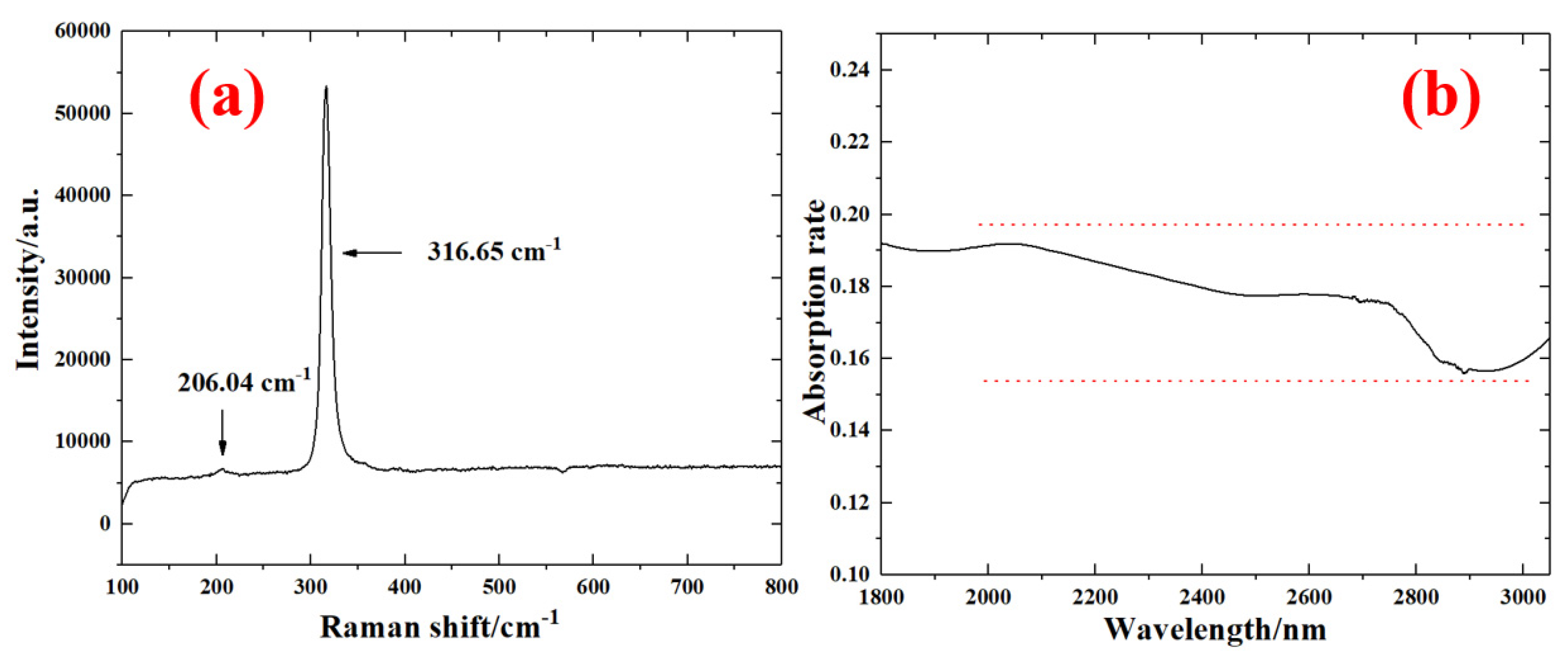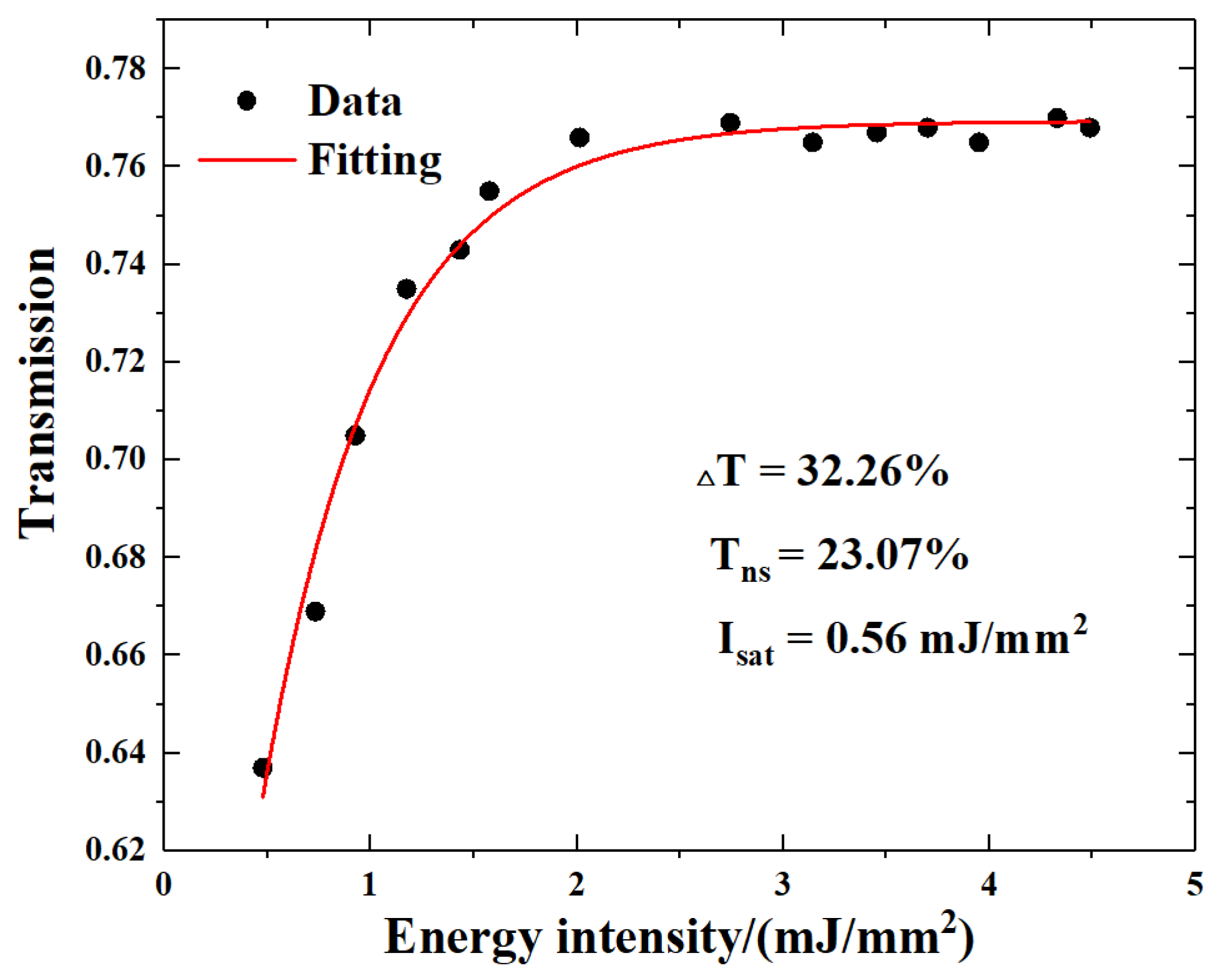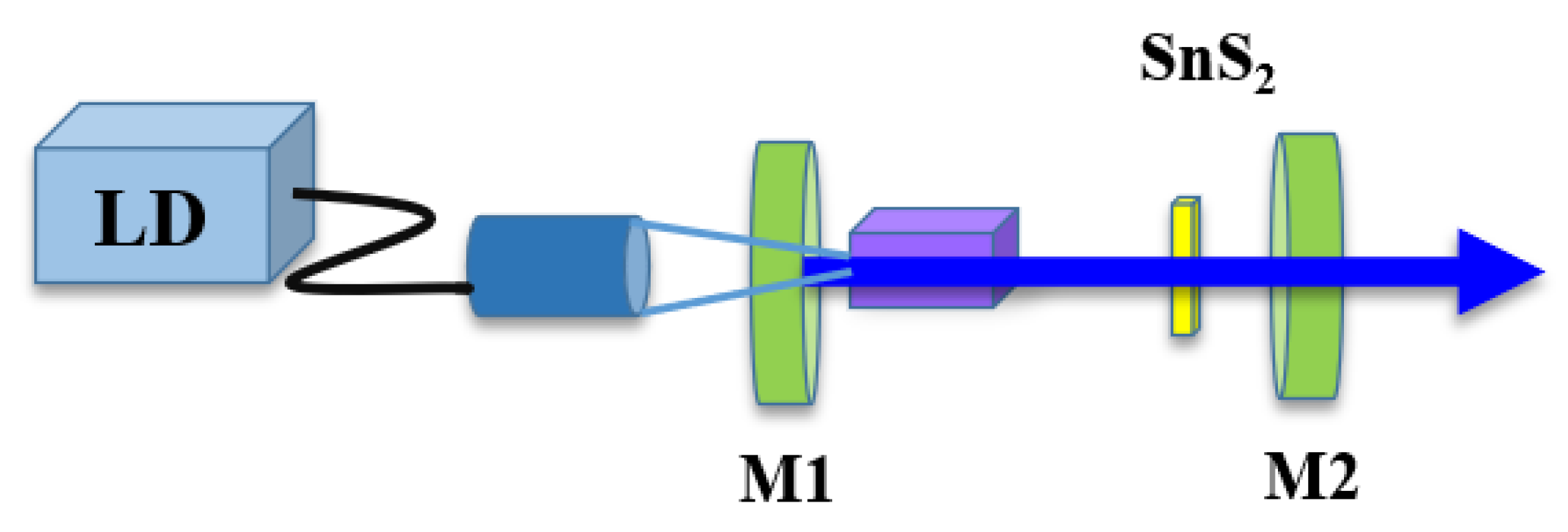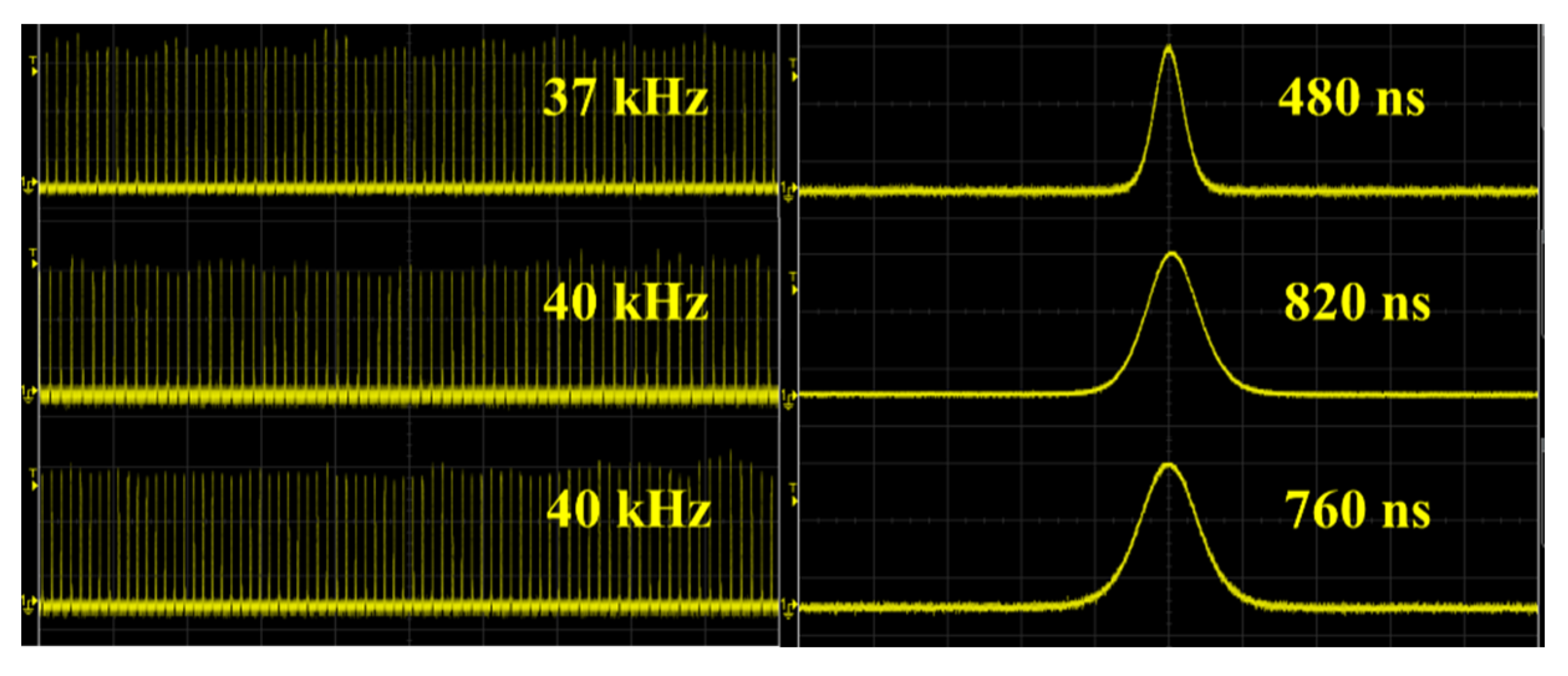SnS2 as a Saturable Absorber for Mid-Infrared Q-Switched Er:SrF2 Laser
Abstract
1. Introduction
2. Characterization of SnS2 SA
3. Pulse Laser Experiments
4. Conclusions
Author Contributions
Funding
Data Availability Statement
Conflicts of Interest
References
- Seddon, A.B. A prospective for new mid-infrared medical endoscopy using chalcogenide glasses. Int. J. Appl. Glass Sci. 2011, 2, 177–191. [Google Scholar] [CrossRef]
- Xiong, Z.; Jiang, L.; Cheng, T.; Jiang, H. 100 Hz repetition-rate 2.794 μm Cr,Er:YSGG passively Q-switched laser with Fe2+:ZnSe saturable absorber. Infrared Phys. Technol. 2022, 122, 104087. [Google Scholar] [CrossRef]
- Serebryakov, V.A.; Boĭko, É.V.; Petrishchev, N.N.; Yan, A.V. Medical applications of mid-IR lasers-problems and prospects. J. Opt. Technol. 2010, 77, 6–17. [Google Scholar] [CrossRef]
- Bagdasarov, K.S.; Zhekov, V.I.; Lobachev, V.A.; Murina, T.M.; Prokhorov, A.M. Steady-state emission from a Y3Al5O12: Er3+ laser (λ = 2.94 μ, T = 300° K). Sov. J. Quantum Electron. 1983, 13, 262–263. [Google Scholar] [CrossRef]
- Ren, X.; Wang, Y.; Zhang, J.; Tang, D.; Shen, D. Short-pulse-width repetitively Q-switched ~2.7-µm Er:Y2O3 ceramic laser. Appl. Sci. 2017, 7, 1201. [Google Scholar] [CrossRef]
- Ma, W.; Qian, X.; Wang, J.; Liu, J.; Fan, X.; Liu, J.; Su, L.; Xu, J. Highly efficient dual-wavelength mid-infrared CW laser in diode end-pumped Er:SrF2 single crystals. Sci. Rep. 2016, 6, 36635. [Google Scholar] [CrossRef]
- Liu, J.; Liu, J.; Guo, Z.; Zhang, H.; Ma, W.; Wang, J.; Su, L. Dual-wavelength Q-switched Er:SrF2 laser with a black phosphorus absorber in the midinfrared region. Opt. Express 2016, 24, 30289–30295. [Google Scholar] [CrossRef]
- Wang, Y.; Wang, J.; Wen, Q. MXene/Graphene oxide heterojunction as a saturable absorber for passively Q-switched solid-state pulse lasers. Nanomaterials 2021, 11, 720. [Google Scholar] [CrossRef]
- Zhang, Y.; Lu, D.; Yu, H.; Zhang, H. Low-dimensional saturable absorbers in the visible spectral region, Adv. Opt. Mater. 2018, 7, 1800886. [Google Scholar] [CrossRef]
- Guo, X.; Wang, S.; Yan, P.; Wang, J.; Yu, L.; Liu, W.; Zheng, Z.; Guo, C.; Ruan, S. High modulation depth enabled by Mo2Ti2C3Tx MXene for Q-switched pulse generation in a mid-infrared fiber laser. Nanomaterials 2022, 12, 1343. [Google Scholar] [CrossRef]
- Liu, J.; Yang, F.; Lu, J.; Ye, S.; Guo, H.; Nie, H.; Zhang, J.; He, J.; Zhang, B.; Ni, Z. High output mode-locked laser empowered by defect regulation in 2D Bi2O2Se saturable absorber. Nat. Commun. 2022, 13, 3855. [Google Scholar] [CrossRef] [PubMed]
- Feng, T.; Mao, D.; Cui, X.; Li, M.; Song, K.; Jiang, B.; Lu, H.; Quan, W. A filmy black-phosphorus polyimide saturable absorber for Q-switched operation in an erbium-doped fiber laser. Materials 2016, 9, 917. [Google Scholar] [CrossRef] [PubMed]
- Mak, K.F.; Shan, J. Photonics and optoelectronics of 2D semiconductor transition metal dichalcogenides. Nat. Photonics 2016, 10, 216–226. [Google Scholar] [CrossRef]
- Yang, Z.; Yang, Q.; Ren, X.; Tian, Y.; Zu, Y.; Li, C.; Din, S.Z.U.; Leng, J.; Liu, J. Passively mode-locked red Pr:LiYF4 laser based on a two-dimensional palladium diselenide saturable absorber. Opt. Express 2022, 30, 2900–2908. [Google Scholar] [CrossRef] [PubMed]
- Fadhel, M.M.; Ali, N.; Rashid, H.; Sapiee, N.M.; Hamzah, A.E.; Zan, M.S.D.; Aziz, N.A.; Arsad, N. A review on rhenium disulfide: Synthesis approaches, optical properties, and applications in pulsed lasers. Nanomaterials 2021, 11, 2367. [Google Scholar] [CrossRef]
- Zhang, B.; Liu, J.; Wang, C.; Yang, K.; Lee, C.; Zhang, H.; He, J. Recent progress in 2D material-based saturable absorbers for all solid-state pulsed bulk lasers. Laser Photonics Rev. 2020, 14, 1900240. [Google Scholar] [CrossRef]
- Li, C.; Yang, Z.; Yang, Q.; Zu, Y.; Din, S.Z.U.; Li, H.; Li, M. LD pumped passively Q-switched Pr:YLF lasers using VS2 SA. Opt. Mater. Express 2022, 12, 4191–4198. [Google Scholar] [CrossRef]
- Su, X.; Zhang, B.; Wang, Y.; He, G.; Li, G.; Lin, N.; Yang, K.; He, J.; Liu, S. Broadband rhenium disulfide optical modulator for solid-state lasers. Photonics Res. 2018, 6, 498–505. [Google Scholar] [CrossRef]
- Yan, B.; Zhang, B.; Nie, H.; Wang, H.; Li, G.; Sun, X.; Wang, R.; Lin, N.; He, J. High-power passively Q-switched 2.0 μm all-solid-state laser based on a MoTe2 saturable absorber. Opt. Express 2018, 26, 18505–18512. [Google Scholar] [CrossRef]
- Liu, X.; Li, X.; Lv, S.; Luo, W.; Xu, W.; Shi, Z.; Ren, Y.; Zhang, C.; Zhang, K. Electrochemical peeling few-layer SnSe2 for high-performance ultrafast photonics. ACS Appl. Mater. Interfaces 2020, 12, 43049–43057. [Google Scholar]
- Niu, K.; Chen, Q.; Sun, R.; Man, B.; Zhang, H. Passively Q-switched erbium-doped fiber laser based on SnS2 saturable absorber. Opt. Mater. Express 2017, 7, 3934–3943. [Google Scholar] [CrossRef]
- Shi, Z.; Sun, X.; Xie, W.; Chang, P.; Li, S.; Zhang, L.; Yang, X. Passively Q-switched Tm:YAP laser based on SnS2 saturable absorber. Optik 2022, 264, 169421. [Google Scholar] [CrossRef]
- Feng, T.; Zhang, D.; Li, X.; Abdul, Q.; Shi, Z.; Lu, J.; Guo, P.; Zhang, Y.; Liu, J.; Wang, Q.J. SnS2 nanosheets for Er-doped fiber lasers. ACS Appl. Nano Mater. 2019, 3, 674–681. [Google Scholar] [CrossRef]
- Liu, G.; Lyu, Y.; Li, Z.; Wu, T.; Yuan, J.; Yue, X.; Zhang, H.; Zhang, F.; Fu, S. Q-switched erbium-doped fiber laser based on silicon nanosheets as saturable absorber. Optik 2020, 202, 163692. [Google Scholar] [CrossRef]
- Liu, M.; Wu, H.; Liu, X.; Wang, Y.; Lei, M.; Liu, W.; Guo, W.; Wei, Z. Optical properties and applications of SnS2 SAs with different thickness. Opto-Electronic Adv. 2021, 4, 200029. [Google Scholar] [CrossRef]
- Niu, K.; Sun, R.; Chen, Q.; Man, B.; Zhang, H. Passively mode-locked Er-doped fiber laser based on SnS2 nanosheets as a saturable absorber. Photonics Res. 2018, 6, 72–76. [Google Scholar] [CrossRef]
- Li, J.; Zhao, Y.; Chen, Q.; Niu, K.; Sun, R.; Zhang, H. Passively mode-locked ytterbium-doped fiber laser based on SnS2 as saturable absorber. IEEE Photonics J. 2017, 9, 1506707. [Google Scholar] [CrossRef]
- Gao, J.; Pan, J.; Liu, Y.; Guo, Q.; Han, X.; Shang, X.; Guo, L.; Zuo, Z.; Man, B.; Zhang, H.; et al. Observation of the dispersion effect of SnS2 nanosheets in all-normaldispersion Yb-doped mode-locked fiber laser. Infrared Phys. Technol. 2019, 102, 102982. [Google Scholar] [CrossRef]
- Nie, H.; Sun, X.; Zhang, B.; Yan, B.; Li, G.; Wang, Y.; Liu, J.; Shi, B.; Liu, S.; He, J. Few-layer TiSe2 as a saturable absorber for nanosecond pulse generation in 2.95 μm bulk laser. Opt. Lett. 2018, 43, 3349–3352. [Google Scholar] [CrossRef]
- Fan, M.; Li, T.; Zhao, S.; Li, G.; Gao, X.; Yang, K.; Li, D.; Kränkel, C. Multilayer black phosphorus as saturable absorber for an Er:Lu2O3 laser at ∼3 μm. Photon. Res. 2016, 4, 181–186. [Google Scholar] [CrossRef]
- Feng, C.; Ma, B.; Qiao, W.; Li, G.; Zhao, J.; Yang, K.; Li, D.; Li, G.; Zhao, S.; Li, T. Passively Q-switched Er:Lu2O3 laser at 2.8 µm with TiC saturable absorber. Appl. Optics 2020, 59, 8066–8070. [Google Scholar] [CrossRef]
- Yan, Z.; Li, T.; Zhao, J.; Yang, K.; Li, D.; Li, G.; Fan, M.; Zhang, S.; Zhao, S. Passively Q-switched 2.85 µm Er:Lu2O3 laser with WSe2. Laser Phys. Lett. 2018, 15, 085802. [Google Scholar] [CrossRef]
- Feng, C.; Qiao, W.; Liu, Y.; Huang, J.; Liang, Y.; Zhao, Y.; Song, Y.; Li, T. Modulation of MXene Nb2CTx saturable absorber for passively Q-switched 2.85 µm Er:Lu2O3 laser. Opt. Lett. 2021, 46, 1385–1388. [Google Scholar] [CrossRef] [PubMed]
- Li, G.; Li, T.; Qiao, W.; Feng, T.; Feng, C.; Zhao, J.; Li, G.; Zhao, S. Passively Q-switched Er:Lu2O3 laser with MXene material Ti4N3Tx (T = F, O, or OH) as a saturable absorber. Opt. Lett. 2020, 45, 4256–4259. [Google Scholar] [CrossRef] [PubMed]
- Fan, M.; Li, T.; Zhao, S.; Li, G.; Ma, H.; Gao, X.; Kränkel, C.; Huber, G. Watt-level passively Q-switched Er:Lu2O3 laser at 2.84 μm using MoS2. Opt. Lett. 2016, 41, 540–543. [Google Scholar] [CrossRef] [PubMed]
- Yao, Y.; Cui, N.; Wang, Q.; Dong, L.; Liu, S.; Sun, D.; Zhang, H.; Li, D.; Zhang, B.; He, J. Highly efficient continuous-wave and ReSe2 Q-switched ∼3 μm dual-wavelength Er:YAP crystal lasers. Opt. Lett. 2019, 44, 2839–2842. [Google Scholar] [CrossRef]
- Fan, M.; Li, T.; Zhao, J.; Zhao, S.; Li, G.; Yang, K.; Su, L.; Ma, H.; Kränkel, C. Continuous wave and ReS2 passively Q-switched Er:SrF2 laser at ∼3 μm. Opt. Lett. 2018, 43, 1726–1729. [Google Scholar] [CrossRef]
- Liu, J.; Huang, H.; Zhang, F.; Zhang, Z.; Liu, J.; Zhang, H.; Su, L. Bismuth nanosheets as a Q-switcher for a mid-infrared erbium-doped SrF2 laser. Photonics Res. 2018, 6, 762–767. [Google Scholar] [CrossRef]







| SA | Gain | Modulation Depth /% | Output Power /mW | Pulse Width /ns | Repetition Rate /kHz | Pulse Energy /μJ | Wavelength/μm | Ref. |
|---|---|---|---|---|---|---|---|---|
| TiSe2 | Ho,Pr:LLF | 9.2 | 130 | 160.5 | 98.8 | 1.32 | 2.95 | [29] |
| BP | Er:Lu2O3 | 8 | 755 | 359 | 107 | 7.1 | 2.84 | [30] |
| TiC | Er:Lu2O3 | 5.5 | 896 | 266.8 | 136.9 | 6.5 | 2.85 | [31] |
| WSe2 | Er:Lu2O3 | 5.3 | 776 | 280 | 121 | 6.6 | 2.85 | [32] |
| Nb2CTx | Er:Lu2O3 | 7.1 | 542 | 223.7 | 142.9 | 3.79 | 2.85 | [33] |
| Ti4N3Tx | Er:Lu2O3 | 8.6 | 778 | 278.4 | 113.7 | 6.84 | 2.85 | [34] |
| MoS2 | Er:Lu2O3 | 20.7 | 1030 | 335 | 121 | 8.5 | 2.84 | [35] |
| ReSe2 | Er:YAP | 7.5 | 526 | 202.8 | 244.6 | 2.2 | 2.73 + 2.80 | [36] |
| ReS2 | Er:SrF2 | 3.8 | 580 | 508 | 49 | 12.1 | 2.79 | [37] |
| Bi | Er:SrF2 | 1.82 | 226 | 980 | 56.2 | 4.02 | 2.73 + 2.75 | [38] |
| SnS2 | Er:SrF2 | 32.26 | 140 | 480 | 37 | 3.78 | 2.73 + 2.75 | This work |
| SnS2 | Er:SrF2 | 32.26 | 87 | 820 | 40 | 2.18 | 2.73 | |
| SnS2 | Er:SrF2 | 32.26 | 149 | 760 | 40 | 3.73 | 2.73 + 2.75 |
Disclaimer/Publisher’s Note: The statements, opinions and data contained in all publications are solely those of the individual author(s) and contributor(s) and not of MDPI and/or the editor(s). MDPI and/or the editor(s) disclaim responsibility for any injury to people or property resulting from any ideas, methods, instructions or products referred to in the content. |
© 2023 by the authors. Licensee MDPI, Basel, Switzerland. This article is an open access article distributed under the terms and conditions of the Creative Commons Attribution (CC BY) license (https://creativecommons.org/licenses/by/4.0/).
Share and Cite
Li, C.; Yang, Q.; Zu, Y.; Din, S.Z.U.; Yue, Y.; Zhai, R.; Jia, Z. SnS2 as a Saturable Absorber for Mid-Infrared Q-Switched Er:SrF2 Laser. Nanomaterials 2023, 13, 1989. https://doi.org/10.3390/nano13131989
Li C, Yang Q, Zu Y, Din SZU, Yue Y, Zhai R, Jia Z. SnS2 as a Saturable Absorber for Mid-Infrared Q-Switched Er:SrF2 Laser. Nanomaterials. 2023; 13(13):1989. https://doi.org/10.3390/nano13131989
Chicago/Turabian StyleLi, Chun, Qi Yang, Yuqian Zu, Syed Zaheer Ud Din, Yu Yue, Ruizhan Zhai, and Zhongqing Jia. 2023. "SnS2 as a Saturable Absorber for Mid-Infrared Q-Switched Er:SrF2 Laser" Nanomaterials 13, no. 13: 1989. https://doi.org/10.3390/nano13131989
APA StyleLi, C., Yang, Q., Zu, Y., Din, S. Z. U., Yue, Y., Zhai, R., & Jia, Z. (2023). SnS2 as a Saturable Absorber for Mid-Infrared Q-Switched Er:SrF2 Laser. Nanomaterials, 13(13), 1989. https://doi.org/10.3390/nano13131989





